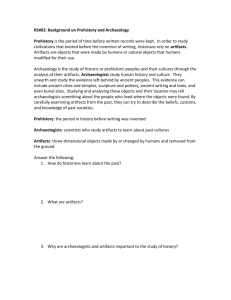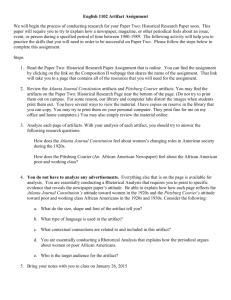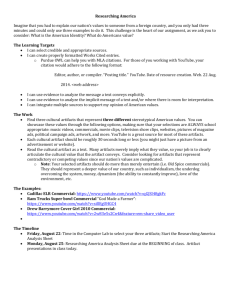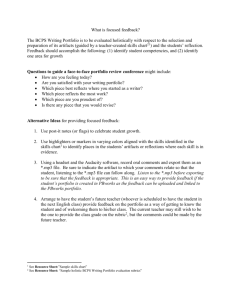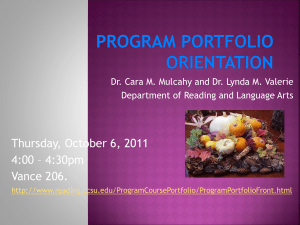The Learning Portfolio - An Across the Curriculum Perspective
advertisement
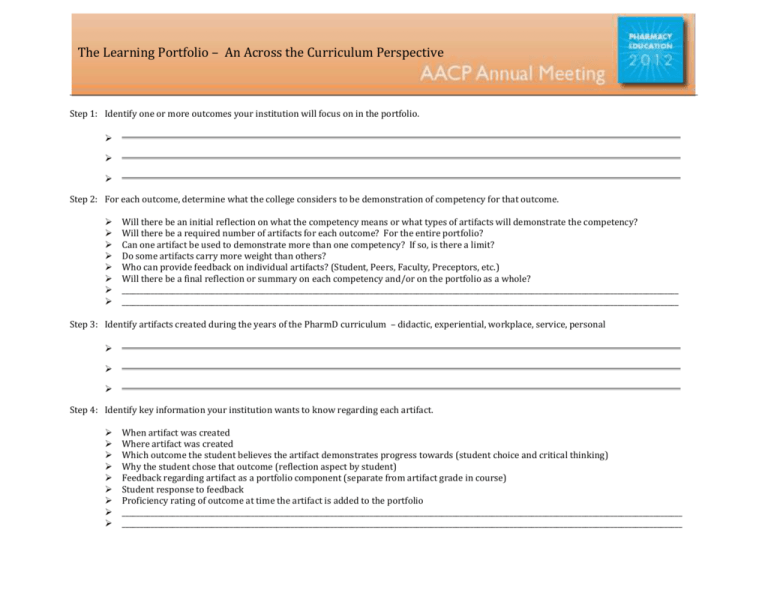
The Learning Portfolio – An Across the Curriculum Perspective Step 1: Identify one or more outcomes your institution will focus on in the portfolio. Step 2: For each outcome, determine what the college considers to be demonstration of competency for that outcome. Will there be an initial reflection on what the competency means or what types of artifacts will demonstrate the competency? Will there be a required number of artifacts for each outcome? For the entire portfolio? Can one artifact be used to demonstrate more than one competency? If so, is there a limit? Do some artifacts carry more weight than others? Who can provide feedback on individual artifacts? (Student, Peers, Faculty, Preceptors, etc.) Will there be a final reflection or summary on each competency and/or on the portfolio as a whole? ___________________________________________________________________________________________________________________________________________________________ ___________________________________________________________________________________________________________________________________________________________ Step 3: Identify artifacts created during the years of the PharmD curriculum – didactic, experiential, workplace, service, personal Step 4: Identify key information your institution wants to know regarding each artifact. When artifact was created Where artifact was created Which outcome the student believes the artifact demonstrates progress towards (student choice and critical thinking) Why the student chose that outcome (reflection aspect by student) Feedback regarding artifact as a portfolio component (separate from artifact grade in course) Student response to feedback Proficiency rating of outcome at time the artifact is added to the portfolio ____________________________________________________________________________________________________________________________________________________________ ____________________________________________________________________________________________________________________________________________________________ The Learning Portfolio – An Across the Curriculum Perspective Step 5: Introduce Portfolio to Students and Faculty (With enthusiasm and excitement!) Step 6: Assess the Big Picture Artifact Outcome(s) When Produced? Where Produced? Format of Artifact Complexity of Artifact Who Provided Feedback? * Portfolio Completion Rate Are artifacts available from all components and aspects of the curriculum? Didactic? Experiential? Workplace? Life skills? Are artifacts available in a variety of formats and media? Reports? Posters? Papers? Pictures? Video? Photos? Sound bites? Are there enough artifacts available to allow for student choice and creativity in the selection process? Is feedback being provided through a variety of sources, not just students themselves and peers? ______________________________________________________________________________________________________________________________________________________________ ______________________________________________________________________________________________________________________________________________________________ Ten Key Concepts for a Pharmacy College Learning Portfolio: 1. If the student is told what artifact to use, where to put it, and what to say about it, the portfolio will become a mindless checklist, not a tool for creative and critical thinking. 2. A learning portfolio is not a collection of pharmacy college memorabilia. 3. A learning portfolio is not a collection of reflections. Some artifacts may be reflections, but the major role of critical thinking and reflection is in the selection of artifacts, deciding what outcomes the artifact demonstrates, thinking about and describing those decisions and the learning process, and at designated points explaining how those artifacts demonstrate growth in and achievement of desired outcomes. 4. A learning portfolio is not a collection of “best work”. 5. Artifacts come from what students are already doing. If your institution is graduating students that meet your outcomes, then the artifacts already exist. Don’t create extra work for the portfolio! 6. Allow students to be creative in determining the format of their artifacts. Photos, drawings, poems, sound bites are legitimate artifacts. 7. Feedback on artifacts is NOT the grade the artifact received in the course or rotation it was created for. Grading is determined by course requirements. Artifact feedback is based on why the artifact was chosen to demonstrate movement towards an outcome and how well the student justifies that choice. Consequently, course faculty are NOT good at providing feedback on artifacts they graded for the course. 8. Artifacts without legitimate feedback turn the portfolio into a collage of memorabilia. Timely and interactive feedback is a key requirement for a learning portfolio to maintain relevancy for students. 9. Artifact feedback should focus on each student’s reflective and critical thinking skills, not on their grammar or spelling skills. If professional writing skills are a concern they should be addressed in the curriculum, not in the portfolio. 10. The portfolio is the responsibility of the entire college, not one department or division. Adequate staffing for the portfolio is a must, or none of the above components will be achieved.



